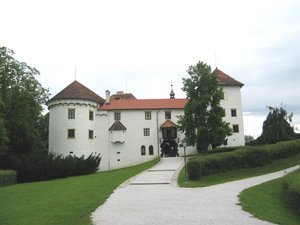Advertisement
Published: October 3rd 2009

 BOGENSPERK CASTLE
BOGENSPERK CASTLE
SITS ISOLATED ON TOP OF THE MOUNTAIN(Excerpts from my book OUR SUMMER IN SLOVENIA, Amazon.com)
As I have noted before, a major factor in Elysee and I deciding to spend a summer in Slovenia, is it being excellently situated to enable side trips to other countries. It is possible to easily drive from Bled to Budapest in six or seven hours. In our case, being in no hurry, we took several days stopping overnight at Celje, Slovenia, visiting Maribor, Slovenia's second largest city (110 thousand) and then stopping overnight again in the Lake Balaton region of Hungary. From there we drove on into Budapest. The following day we met up with our friends from Florida, Char and Al Love, for several days of adventure.
First things first. We did not begin with the intention of staying in Celje. But, as is our style we took back roads in our general direction, being open minded about seeing and learning more about this great country of Slovenia. Not too long after leaving Bled we saw a road sign beckoning us to visit Bogensperk Castle. I'm not a "gotta see this castle" type of person. You can waste your life visiting castle ruins in Europe and die not

 BANQUET HALL
BANQUET HALL
SET UP FOR A WEDDINGhaving finished the job. In fact, had we known the castle was a long ride up a lonely mountain road, and somewhat out of our way, we would have declined. But once committed, we determined to see it through and came at road's end to the entrance of the castle, finding that we were the only ones there to take a tour with a very bored summer intern. The castle dates from 1511, being built by the feudal lords von wagen. They built their castle on an enormous rock because their previous property had been destroyed in an earthquake. The castle reached it glory during the end of the 17th century when the Slovenian scientist and historian Janez Valvasor lived and worked there., Valvasor, a former soldier, previously had traveled throughout Europe and North Africa, and was a man of the world. However, during his 20 years at the castle he adopted a studious life, undertaking many research projects, the most famous being the 3,532 page history of Carniola released in 1689. He trained his workers to in copperplate pripnting and produced exquisite, detailed prints of life at that time including painstaking folio pages. This monumental work about Valvasor's Carniola region is an invaluable source today about the life and times of the late 17th century.
Being an inquisitive man of scientific bent, he also disproved what many peasants thought to be mysterious witchcraft; for example, the inexplicable rising and falling of the nearby lakes which peasantry believed to be induced by witches. He learned of a series of underground lakes and limestone caves that rose and fell according to scientific factors such as periodic rainfall and drought. For documenting his findings scientifically and disproving witchcraft, Valvasor was admitted to the prestigious London Royal Society, a distinct honor for a person so far removed from the mainstream of commerce and knowledge. He was self-funded and his endeavors brought him to the brink of bankruptcy and in 1692 he sold all of his property, dying a year after. A copy of Valvasor's monumental work is on display.
Advertisement
Tot: 0.743s; Tpl: 0.021s; cc: 9; qc: 51; dbt: 0.3867s; 1; m:domysql w:travelblog (10.17.0.13); sld: 1;
; mem: 1.1mb

 BOGENSPERK CASTLE
BOGENSPERK CASTLE
 BANQUET HALL
BANQUET HALL